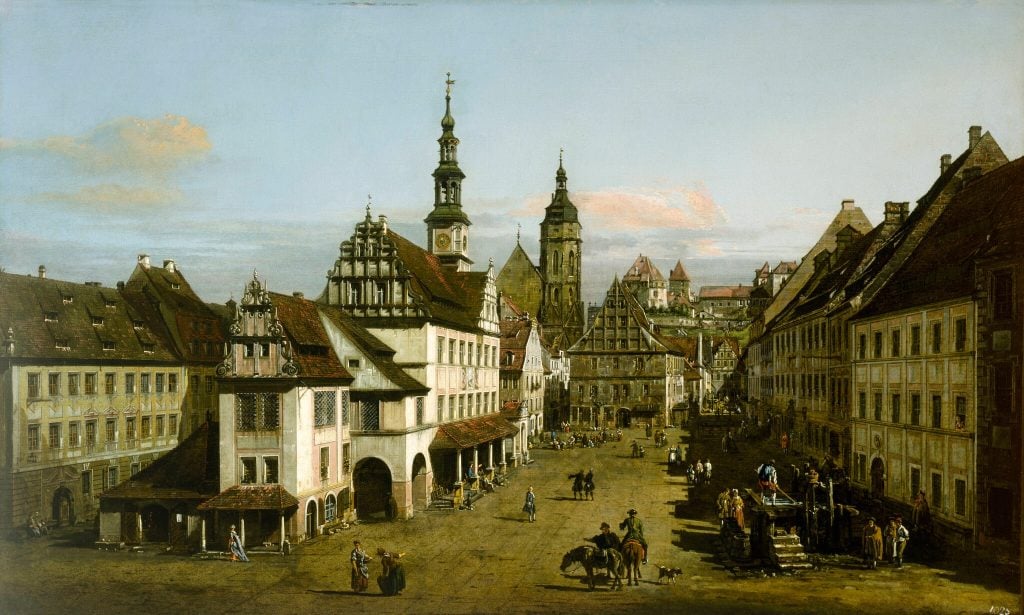Law & Politics
MFA Houston Wins Appeal to Keep a Nazi-Seized Bellotto Painting
The ownership of the painting has been at the center of a decades-long dispute stemming from a clerical error.

The ownership of the painting has been at the center of a decades-long dispute stemming from a clerical error.

Adam Schrader

The Museum of Fine Arts, Houston, won an appeal to keep a Bernardo Bellotto painting seized by the Nazis during World War II. The decision by the U.S. Federal Court of Appeals for the Fifth Circuit likely ends a complex saga triggered by a clerical error the Monuments Men made when they retrieved it and other works from an Austrian salt mine in 1945.
The challenge to museum’s ownership of the painting Marketplace at Pirna (c. 1764) “has been definitively resolved,” representatives for MFA Houston said in a statement. This latest ruling by the appeals court panel is the third to reject the claim made by the heirs.
The heirs of Jewish art collector Max Emden filed the lawsuit against the museum in 2021 claiming that the painting was sold by the department store magnate under duress.
Though Emden had moved to a private island in Switzerland in 1927, he still owned his textile trading company in Berlin and had German bank accounts. His German assets were frozen and ultimately liquidated by Nazis. He hired Jewish dealer Anna Caspari, who was later killed by the Nazis in German-occupied Lithuania, to sell three works.
The three works, which included Marketplace at Pirna, were sold to a German art dealer named Karl Haberstock in 1938, before the war, after Emden had the works shipped to multiple cities in Europe for potential buyers to see. Haberstock paid Emden’s full asking price of 60,000 Swiss Francs for the works and then resold them to the Reichskanzlei for the planned Führermuseum. Emden’s heirs argued that the works were sold below market value.
“The MFAH had previously researched the claims’ merits and had shared the independent international provenance investigation, which demonstrated that the claims of a forced sale, or sale at less than fair market value, were not valid,” the museum said in its statement. “No new information has come to light to alter our conclusion that the 1938 sale initiated by Dr. Emden was voluntary.”
But the case was not decided on the merits of that sale. Rather, the three works were separated after the war due to a clerical mix-up. Two of them went to Germany and were restituted to the family in 2019 after a German Advisory Commission ruling found the sale was “not undertaken voluntarily but was entirely due to worsening economic hardship.”
The third, the MFA Houston painting, was accidentally tagged by the Monuments Men to go to the Netherlands instead of a copy of the same work that was owned by another Jewish collector named Hugo Moser. The copy was purchased by Maria Almas-Dietrich, one of Hitler’s most important art suppliers, for the Führermuseum when he fled Amsterdam. The Monuments Men had confiscated Almas-Dietrich’s collection, including the copy of Marketplace at Pirna, in 1945 and stored it at the Munich Central Collecting Point, the same place the Emden artworks were later kept.
As nations sought to restitute artworks in the aftermath of the war, the Dutch government reached out to restitute Marketplace at Pirna to Moser, not knowing that the work to be returned was a copy. By the time the Monuments Men realized the error in 1949, Moser had already received the original painting.
Moser created a new provenance for the painting and sold it in 1952 to American collector Samuel H. Kress who donated it to MFA Houston in 1961. The Emden heirs claim the original painting should be returned to them because Moser never received a good title to it.
The decision by the appeals court marks the third time that the Emden’s restitution case has been dismissed. Previously, a federal district court had dismissed the lawsuit without prejudice, allowing the heirs to refile their claim.
The district court determined that act-of-state doctrine should apply to the case because the heirs had attributed the errors to the Dutch government. Under act-of-state doctrine, acts done by foreign nation in its own territory cannot be challenged in American courts.
The heirs refiled, shifting some of the blame off the Dutch government to the Netherlands Art Property Foundation (SNK), which was established by the Dutch government to handle such matters, but the district court still sided with the museum and dismissed the lawsuit—this time with prejudice. The heirs appealed, and the appeals court affirmed the lower court’s decision again on the principle of act-of-state doctrine.
The appeals court ruled that SNK “had sufficient governmental trappings” and “has been recognized as an official actor” and that ruling in favor of Emden could have “an implied negative foreign relations impact.” The transfer of the painting to Moser also occurred within the Netherlands.
“The Emdens may be right,” the court wrote. The Monuments Men may have improperly sent the painting to the SNK which may have unjustifiably sent it to Moser, meaning the museum may be violating the Washington Principles by refusing to return it. “But, per the act of state doctrine, it is not our job to call into question the decisions of foreign nations.”